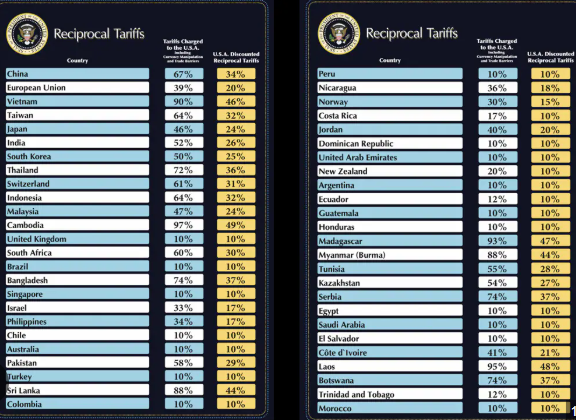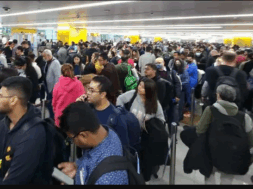
Roving Periscope: Trump tariffs trigger market crash; trillions lost, global recession feared
Virendra Pandit
New Delhi: As the US started collecting the initial ‘baseline’ 10 percent tariff on Friday, the Wall Street crashed, and J.P. Morgan Chase & Co. feared that the American economy could fall into a recession in 2025 itself after accounting for the likely impact of the 10 to 49 percent tariffs announced this week by President Donald Trump’s administration.
J P Morgan expects real GDP growth of -0.3 percent for full year, down from 1.3 percent previously, the media reported on Saturday. It was forecasting a 60 percent chance of the global economy entering a recession by year-end, up from 40 percent previously.
“We now expect real GDP to contract under the weight of the tariffs, and for the full year (4Q/4Q) we now look for real GDP growth of -0.3 per cent, down from 1.3 per cent previously,” the bank’s chief US economist, Michael Feroli, said on Friday in a note to clients, referring to GDP.
“The forecasted contraction in economic activity is expected to depress hiring and overtime to lift the unemployment rate to 5.3 percent,” Feroli said.
Markets crash
On Friday, the Wall Street nosedived for a second straight day, confirming the Nasdaq Composite was in a bear market and the Dow Jones Industrial Average was in a correction, as an escalating global trade war spurred the biggest losses since the COVID-19 pandemic in 2020. For Thursday and Friday, the Dow was down 9.3 percent, the S&P 500 10.5 percent and the Nasdaq 11.4 percent.
Wall Street was firmly in the grip of bears as the S&P 500 and the tech-heavy Nasdaq opened 2.5-3 per cent down and looked set for their worst 2-day fall since March 2020. The Dow Jones Industrial opened 2.2 per cent lower.
Fallout from Trump’s sweeping tariffs stoked fears of a global recession, wiping trillions of dollars of value from US companies. Highlighting growing panic among investors, the CBOE Volatility Index, or Wall Street’s fear gauge, closed at its highest level since April 2020.
Since late on Wednesday, when Trump boosted tariff barriers to their highest level in more than a century, investors have dumped stocks, fearing both the new US economic reality and also how US trading partners might retaliate by steepening their own trade barriers.
A record-breaking number of shares were traded on Friday, with volume on US exchanges around 26.79 billion shares, beating the previous high of 24.48 billion shares traded on January 27, 2021.
World governments began reacting to Trump’s tariff announcement on Friday, further undermining investor sentiment that a global recession could be averted.
China’s finance ministry imposed additional tariffs of 34 percent on all US goods from April 10.
Meanwhile, the prime ministers of Britain, Australia and Italy held talks on how to respond to Trump’s tariff salvo.
“We’re in the Wild West of a trade war right now,” said Mariam Adams, managing director at UBS Wealth Management.
US Federal Reserve Chair Jerome Powell spoke publicly for the first time since Trump’s tariff announcement. He highlighted the unexpectedly hefty tariffs could trigger higher inflation and slower growth, setting the stage for challenging decisions for US central bankers.
US-listed shares of Chinese companies dived, with JD.com and Alibaba and Baidu all down more than 7.7 percent. Companies with exposure to China also fell across the board, with mega-caps such as Apple dropping 7.3 percent.
The US markets opened with deep fissures on Friday, as the tremors set off by sweeping import tariffs was exacerbated by China retaliating with 34 percent additional tariffs on US goods entering the country.
The US has imposed a stiff 54 percent tariff on China and iPhone maker Apple Inc., which has a big manufacturing base there, saw its shares fall over 4 percent. Other stocks that tumbled in opening trades were Nvidia, Amazon Inc, and Samsung Electronics, extending their losses from the day before.
The commodities market has also been rocked, with all commodity sub-asset classes ending up in the red on Friday.
Bloomberg Commodity Index declined by nearly 3 percent to 101.59. Energy products such as crude oil, natural gas, heating oil, gasoline, gas and naphtha were one of the asset classes worst hit. Gold, silver, copper, platinum, rubber, cotton, coffee, soyabean, wheat, aluminium and nickel were among other commodities that declined.
Meanwhile, the US Customs agents began collecting President Trump’s unilateral 10 percent tariff on all imports from many countries on Saturday, with higher levies on goods from 57 larger trading partners due to start next week.
The initial 10 percent ‘baseline’ tariff took effect at US seaports, airports and customs warehouses at 12:01 a.m. ET (0401 GMT), ushering in Trump’s full rejection of the post-Second World War system of mutually agreed tariff rates.
“This is the single biggest trade action of our lifetime,” said Kelly Ann Shaw, a trade lawyer at Hogan Lovells and former White House trade adviser during Trump’s first term.
Shaw told a Brookings Institution event on Thursday that she expected the tariffs to evolve over time as countries seek to negotiate lower rates. “But this is huge. This is a pretty seismic and significant shift in the way that we trade with every country on earth,” she added.
Trump’s Wednesday tariff announcement shook global stock markets to their core, wiping out USD 5 trillion in stock market value for S&P 500 companies by Friday’s close, a record two-day decline. Prices for oil and commodities plunged, while investors fled to the safety of government bonds.
Among the countries first hit with the 10 percent tariff are Australia, Britain, Colombia, Argentina, Egypt and Saudi Arabia. A US Customs and Border Protection bulletin to shippers indicates no grace period for cargoes on the water at midnight on Saturday.
But a US Customs and Border Protection bulletin did provide a 51-day grace period for cargoes loaded onto vessels or planes and in transit to the US before 12:01 a.m. ET Saturday. These cargoes need to arrive by 12:01 a.m. ET on May 27 to avoid the 10 percent duty.
Reciprocal tariffs
At the same hour on Wednesday, Trump’s higher “reciprocal” tariff rates of 11 percent to 50 percent are due to take effect. European Union imports will be hit with a 20 percent tariff, while Chinese goods will be hit with a 34 percent tariff, bringing Trump’s total new levies on China to 54 per cent.
Vietnam, which benefited from the shift of US supply chains away from China after Trump’s first-term trade war with Beijing, will be hit with a 46 percent tariff and agreed on Friday to discuss a deal with Trump.
Canada and Mexico were exempt from both Trump’s latest duties because they are still subject to a 25 percent tariff related to the US fentanyl crisis for goods that do not comply with the US-Mexico-Canada rules of origin.
Trump is excluding goods subject to separate, 25 percent national security tariffs, including steel and aluminium, cars, trucks and auto parts.
His administration also released a list of more than 1,000 product categories exempted from the tariffs. Valued at USD 645 billion in 2024 imports, these include crude oil, petroleum products and other energy imports, pharmaceuticals, uranium, titanium, lumber and semiconductors and copper. Except for energy, the Trump administration is investigating several of these sectors for further national security tariffs.














